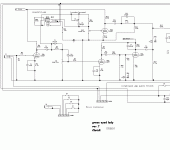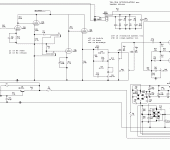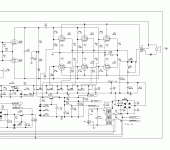here is the first circuit i tried to design, it was totally by the seat of my pants. i reailize their are alot of thing wrong with this circuit and i still don't know enough about tubes or anything else for that matter to be making something so complex. i want to use this as a learning experiance, go easy. 
i had to split the schematic in 3 parts(to big).
edit: this the first tube circuit i tried to design, i've build other SS stuff before.

i had to split the schematic in 3 parts(to big).
edit: this the first tube circuit i tried to design, i've build other SS stuff before.
Attachments
right
those of you who know the insides of guitar amps will recognize the front end as a copy of the slo-100, the power tube section is a modified version of the same. the rest is pure me, it sucks i know. maybe in ten years i'll know how to do it right
this was to use an old soundcity 120 i had, i was going to use the stock transformers.
those of you who know the insides of guitar amps will recognize the front end as a copy of the slo-100, the power tube section is a modified version of the same. the rest is pure me, it sucks i know. maybe in ten years i'll know how to do it right
this was to use an old soundcity 120 i had, i was going to use the stock transformers.
Attachments
self-organizing chaos?
Is that a guitar amp, or an early digital computer?
Dude, you need to rip out 75% of the parts and tubes from that thing... IMHO.
I've built quite a few guitar amps over the years, and the best sounding ones were the simplest. One preamp tube, and one 6V6 output. The Hammond 125ESE is killer for guitar.
Any venue that a 5W amp is too small for, is going to mic you anyway - no matter what you're playing through. You see these guys on stage with their 120W Hi-Watts or Peavey's, and the thing is on "1" so they don't drown out the monitors. The rest of the sound is all PA.
Joel
Is that a guitar amp, or an early digital computer?
Dude, you need to rip out 75% of the parts and tubes from that thing... IMHO.
I've built quite a few guitar amps over the years, and the best sounding ones were the simplest. One preamp tube, and one 6V6 output. The Hammond 125ESE is killer for guitar.
Any venue that a 5W amp is too small for, is going to mic you anyway - no matter what you're playing through. You see these guys on stage with their 120W Hi-Watts or Peavey's, and the thing is on "1" so they don't drown out the monitors. The rest of the sound is all PA.

Joel
I just repaired a Marshall Major for someone. Thats 200W of valve power. I had to explain to the man that in order to get it into decent overdrive territory he would be the loudest thing in the whole town. They mainly play in small pubs.
I really can't see any sense in having a guitar amp of anything more than 20W with a decent sensitivity speaker. Still he picked it up for £120.00 so he got a bargin. I had also to explain to him that a replacement set of KT88's might cost him over £300.00
The overall price to value equation just doesn't stack up.
Shoog
I really can't see any sense in having a guitar amp of anything more than 20W with a decent sensitivity speaker. Still he picked it up for £120.00 so he got a bargin. I had also to explain to him that a replacement set of KT88's might cost him over £300.00
The overall price to value equation just doesn't stack up.
Shoog
this was supposed to be around 150w, i lost the parts for it so it never did get built. i'm suprized no one noticed the big 470uf cap on the 415v B+, i don't even think they make them that big. just one of many mistakes.
chrisr said:i'm suprized no one noticed the big 470uf cap on the 415v B+, i don't even think they make them that big.
They sure do! I have a 470uF @ 450V I used in a project not long ago that I scavenged from a computer SMPS.
470 uF 450 volt, no problem I got a box of 24 on ebay. There are 6 of them in my 845SE amp. I also got some 2400 uF 450 volt caps from ebay. They are almost quart sized and will blow the end off a small screwdriver when accidentally discharged.
I am all for building ridiculously outrageous guitar amps. I am collecting the parts for a 200 Watt single ended guitar amp (833A power tube, digital control, memory etc). Why? Just to have the baddest amp on the block! I know that I can complete this project because I have been building tube amps for almost 40 years, and I have breadboarded and tested each section independantly. My first tube guitar amp was a modified Magnavox mono HiFi amp. I built it in 1966.
That being said, I would definitely start with something much simpler for your first tube design. A simple Fender clone is an excellent starting point, gives you a great learning experience, a great amp when you are done, and an opportunity to begin discovering which parts to tweak to find the right sound.
I don't see any obvious flaws in your design, although I didn't go over it in detail. The problem with a complex design for your first tube amp, is what to do if it doesn't work right the first time. A complex design that doesn't work right can be real hard to troubleshoot. If the amp makes no sound, you can usually figure it out, but what do you do if it hums, or just doesn't sound good? Which of the many stages is causing the problem? Maybe every stage is working individually, but they just dont play well with each other. If your first amp is a two stage Champ clone, it will be easy to get working. Then you build a bigger one. If you build an amp that sounds bad, then you take it appart, and recycle the parts. If you build too many amps, just sell a few to pay for the ones that you want to keep.
I know that this sounds like the long road to take, but I have seen too many people attempt a mega - amp for their first design, then give up on it after spending a lot of time and money. Their first amp was their last, and it wasn't even fun! I have bought a few of these just for the parts. I don't recommend using super premium parts for your first amp either. If things don't work out, you won't have wasted much money. One of the amps that I bought had $800 worth of transformers, and it sounded bad. You can build a Champ clone for around $100 USD.
Yes, I have made crappy sounding amps, and I still do. But I minimize the risk by breadboarding everything I can, before spending big bucks. The 200 watt SE amp took up two benches in prototype form (picture on web site). I used a power supply from an ambulance transmitter, my 845SE stereo for a driver, and an ADA midi preamp for the pragrammable sounds. Now that this all works, I can replace all of the prototype parts with their final pieces, and then design the package for it all. I scored a big transformer on ebay, and am now designing the power supply. The digital controller is being designed seperately.
Why am I explaining this? Because I think you want to build your mega - amp anyway, and this is the only way you will ever make it work. Build it one stage at a time, and find a way to test them, then put it all together. If you haven't already done so, read the safety information of this forum (and the safety pages on my web site) and make sure that you understand the risks involved in playing with this much electricity!
http://www.tubelab.com/Safety.htm
http://www.tubelab.com/MeterUse.htm
http://www.tubelab.com/833SE.htm
I am all for building ridiculously outrageous guitar amps. I am collecting the parts for a 200 Watt single ended guitar amp (833A power tube, digital control, memory etc). Why? Just to have the baddest amp on the block! I know that I can complete this project because I have been building tube amps for almost 40 years, and I have breadboarded and tested each section independantly. My first tube guitar amp was a modified Magnavox mono HiFi amp. I built it in 1966.
That being said, I would definitely start with something much simpler for your first tube design. A simple Fender clone is an excellent starting point, gives you a great learning experience, a great amp when you are done, and an opportunity to begin discovering which parts to tweak to find the right sound.
I don't see any obvious flaws in your design, although I didn't go over it in detail. The problem with a complex design for your first tube amp, is what to do if it doesn't work right the first time. A complex design that doesn't work right can be real hard to troubleshoot. If the amp makes no sound, you can usually figure it out, but what do you do if it hums, or just doesn't sound good? Which of the many stages is causing the problem? Maybe every stage is working individually, but they just dont play well with each other. If your first amp is a two stage Champ clone, it will be easy to get working. Then you build a bigger one. If you build an amp that sounds bad, then you take it appart, and recycle the parts. If you build too many amps, just sell a few to pay for the ones that you want to keep.
I know that this sounds like the long road to take, but I have seen too many people attempt a mega - amp for their first design, then give up on it after spending a lot of time and money. Their first amp was their last, and it wasn't even fun! I have bought a few of these just for the parts. I don't recommend using super premium parts for your first amp either. If things don't work out, you won't have wasted much money. One of the amps that I bought had $800 worth of transformers, and it sounded bad. You can build a Champ clone for around $100 USD.
Yes, I have made crappy sounding amps, and I still do. But I minimize the risk by breadboarding everything I can, before spending big bucks. The 200 watt SE amp took up two benches in prototype form (picture on web site). I used a power supply from an ambulance transmitter, my 845SE stereo for a driver, and an ADA midi preamp for the pragrammable sounds. Now that this all works, I can replace all of the prototype parts with their final pieces, and then design the package for it all. I scored a big transformer on ebay, and am now designing the power supply. The digital controller is being designed seperately.
Why am I explaining this? Because I think you want to build your mega - amp anyway, and this is the only way you will ever make it work. Build it one stage at a time, and find a way to test them, then put it all together. If you haven't already done so, read the safety information of this forum (and the safety pages on my web site) and make sure that you understand the risks involved in playing with this much electricity!
http://www.tubelab.com/Safety.htm
http://www.tubelab.com/MeterUse.htm
http://www.tubelab.com/833SE.htm
your amp must be killer! i don't know if he still hangs around there but but there was this guy named kg who built an amp called bagga (1000 watts) out of kt88's i think.
http://www.firebottle.com/fireforum/fireBB.cgi?cfg=ga&select=ganews&first_days_old=
http://www.firebottle.com/fireforum/fireBB.cgi?cfg=ga&select=ganews&first_days_old=
tubelab.com said:I don't see any obvious flaws in your design
It will be very difficult, if not impossible, to adjust bias for each tube. All tubes on each side have the same (or almost the same) grid potential; they are connected together through three 1.5k resistors. So, if you adjust bias for one tube, you are actually adjusting the bias potentials for all tubes on that side.
Yes, after looking at the schematic now that I am at awake, I see the same issue. There are 6 individual bias adjustments with their outputs all tied together through the grid stopper resistors. This design needs 6 coupling capacitors (one for each output tube) so the grid bias can be adjusted individually.
- Status
- Not open for further replies.
- Home
- Amplifiers
- Tubes / Valves
- time for a laugh



